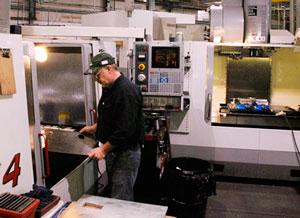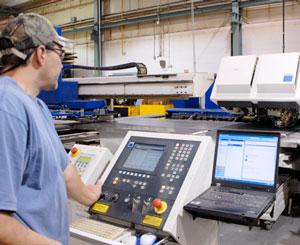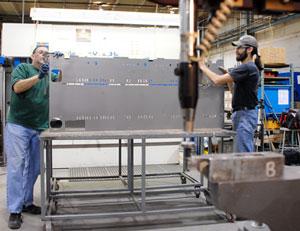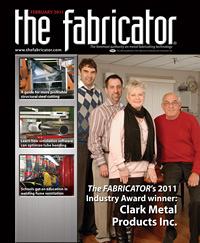Editor-in-Chief
- FMA
- The Fabricator
- FABTECH
- Canadian Metalworking
Categories
- Additive Manufacturing
- Aluminum Welding
- Arc Welding
- Assembly and Joining
- Automation and Robotics
- Bending and Forming
- Consumables
- Cutting and Weld Prep
- Electric Vehicles
- En Español
- Finishing
- Hydroforming
- Laser Cutting
- Laser Welding
- Machining
- Manufacturing Software
- Materials Handling
- Metals/Materials
- Oxyfuel Cutting
- Plasma Cutting
- Power Tools
- Punching and Other Holemaking
- Roll Forming
- Safety
- Sawing
- Shearing
- Shop Management
- Testing and Measuring
- Tube and Pipe Fabrication
- Tube and Pipe Production
- Waterjet Cutting
Industry Directory
Webcasts
Podcasts
FAB 40
Advertise
Subscribe
Account Login
Search
Fabricating of the third-generation kind
Clark Metal Products: The FABRICATOR's 2011 Fabricator of the Year
- By Dan Davis
- January 27, 2011
- Article
- Shop Management

Figure 1: “It means a lot to us to have the business in the family. We want to continue it and do what it takes to get along and pass it on to future generations,” said Rob Clark, Clark Metal Products‘ vice president of operations (second from the left). Other family members involved in the business include (from left to right) Tracie Clark, senior accountant; David Clark Jr., vice president of sales and marketing; and Dave Clark Sr., president. (Photos courtesy of Richard Rich, Imagepoint Pittsburgh.)
Through the starts and stops, confidence building with each new order and downright bewilderment as to where the backlog went, Clark Metal pushed forward. The company recorded a little more than $13 million in sales for 2010, less than its record $15.6 million earned in 2008, but much more robust than competitors.
That alone might have been enough to earn The FABRICATOR’s 2011 Industry Award, but the members of the magazine’s Editorial Advisory Board that selected the winner noted the steps the company had taken in the months leading up to 2010 and the commitment to push forward with the changes even in the face of uncertainty. As one of the judges said, “It is great to see that there are companies that, even with the downturn in the economy, choose to grow in their markets and invest in their long-term growth. Too many companies look at this as a time to cut the corners, reduce expenses, and just wait for the economy to turn around.” That pretty much summed up why the company is honored with this year’s award.
A Solid Fabricating Foundation
Like many other metal fabricating businesses, Clark Metal Products is a family affair (see Figure 1). J.W. Clark started the business in the Blairsville area in 1954. His sons, Jack and Dave, later took over the company, and Dave remains its president. Jack retired in 2001. The third generation is now involved in the business. Dave Clark Jr. is the vice president of sales and marketing, and Rob, Jack’s son, is vice president of operations. Rob’s wife, Tracie, is the company’s senior accountant.
“Who knows? Maybe there will be a fourth generation someday,” Rob Clark said.
If so, the next generation will be walking into a situation that many a metal fabricating shop would be jealous of. Clark Metal moved into its current 68,000-square-foot location in 1993. The company has 53,000 sq. ft. of manufacturing space (see Figure 2) in which to run its manufacturing and finishing operations.
The company primarily works with cold-rolled steel, stainless steel, and aluminum, but also has worked with galvanealed, galvanized, and hot-rolled steel on occasion. It employs a 3,000-W TRUMPF L3030 laser cutting machine for most of its cutting needs. It can cut mild steel up to 0.375 inch and stainless steel and aluminum up to 0.25 in.
For punching and cutting needs, the company has a 3,200-W TRUMPF TC6000 punch/laser combination machine, which can accommodate a workpiece as large as 60 in. by 120 in.; a 30-ton, 58-station Amada Vipros 357 turret punch press; a 30-ton Pierce-All 3025 A Perf-O-Mator; an Amada SP-30 punching machine; and an Amada hydraulic notcher. For bending purposes (see Figure 3), Clark Metal has seven press brakes ranging in size from 5 to 100 tons.
Additionally, the metal fabricator has Miller Electric, Lincoln Electric, and Cobra welding power sources and Koike Aronson welding positioners to assist with all gas metal arc and gas tungsten arc welding jobs. A Timesavers 36-in. web belt machine is used for deburring and brush-finishing ferrous and nonferrous material up to 36 in. wide, and a custom-built Timesavers belt sander is used for brush-finishing aluminum and stainless steel parts.
When customers began requesting more quotes for machining activities in 2002, Clark Metal management decided to take advantage of a favorable financing environment and purchased a Haas VF-4 machining center (see Figure 4). This gave Clark Metal the ability to control lead-times because it no longer had to outsource machining. It added a Haas VF4-SS in 2008.
Clark Metal also offers value-added services to help make the company a one-stop shop for its customers. It has two spray booths for application of polyester, epoxy, and hybrid powder coating finishes; another spray booth for wet spray coatings; and three dryoff ovens for curing. The company also can apply graphics to metal substrates, even creating custom screen stencils from customer-supplied artwork. Additionally, Clark Metal can accommodate requests for assembly assistance and on-site inventory replenishment programs.

Figure 4: The company has no desire to become a machine shop, but does view its ability to offer some machining services through its two vertical machining centers as a competitive advantage.
That’s a complete set of capabilities, but it’s hardly unique in the metal fabricating world. In fact, it is some of the more unusual activities that help Clark Metal stand apart from the competition.
A Unique Approach to Running a Fabricating Business
Rob Clark is active in the Precision Sheet Metal Users Group (PSMUG), a collection of metal fabricators who meet quarterly to compare business notes and share operational philosophies. The group of six companies is an offshoot of a larger gathering of metal fabricators associated with the Fabricators & Manufacturers Association, the parent organization of this magazine.
Even though all the company members in the PSMUG are competitors, they don’t share many of the same customers because the membership is geographically diverse. Clark said that promotes a willingness to share thoughts and opinions and a confidence that such action supports the health of the overall metal fabricating industry, rather than sabotaging one’s own efforts to run a successful company.
“My family ran the business for about 40 years, and they definitely had the mindset where they were very open with employees, but liked to keep everything else kind of private to the outside world,” Clark said. “As long as I’m not broadcasting customer names and who we are doing business for and disclosing drawings and designs, I don’t see the harm in sharing information with others, even if it can benefit them.”
Each member of the PSMUG has hosted the group at his or her own company. Now the group is trying to decide if they would like to start the round-robin visits again or select a new meeting site. Whatever they decide, the enthusiasm of this first group has motivated another group of fabricators to try and duplicate the model.
“I think it is starting to pick up more steam as it keeps going,” Clark said.
So what topics are discussed? Clark said that Clark Metal actually has been the source of good discussion as it pertains to the company’s sales model. It ditched the manufacturing representative model about four years ago, something that some other competitors might be leery to replicate.
Clark admitted the approach took a leap of faith. However, company management thought the model had run its course, particularly as more customers relied more heavily on electronic interaction and exchange of files, and some even requested not to be bothered by in-person visits. It also helped that the company’s engineering manager was willing to step into the role of direct sales.
Four years later, the leap appears to have paid off. Sales have increased, and new customers—such as a manufacturer of stadium displays and a maker of pharmaceutical dispensing equipment—have been cultivated. For 2010, revenues were up 7 percent when compared to the previous year, and operating income was up 150 percent through Sept. 30.
The sales manager, Ron Traister, also made inroads with several customers because he could talk their language, which happened to be engineering.

Figure 7: Employees can access 20 PCs on the shop floor if they need more detailed information about the jobs they are working on.
“That’s an advantage, too, over the rep model. Here is a guy that can sit down with a customer’s engineering manager or design folks and offer advice at the time they are designing a product. That’s a huge, huge plus,” Clark said.
While not a majority, more customers are looking for that type of metal manufacturing expertise from Clark Metal. They are inviting input, and Clark Metal engineers are returning the favor with advice on ways to produce the metal parts more cost-effectively. The early input also is crucial in preventing surprises when manufacturing programs actually commence, which helps get the end product to market faster.
“We’re not just metal benders and a weld shop. They are truly looking at us as being experts in helping their business too,” Clark said.
Customers get their chance each year to see Clark Metal‘s metal manufacturing expertise in a daylong open house event the company calls its Fab Expo. Typically, 35 to 40 engineers, buyers, and quality assurance personnel from Clark Metal‘s top customers are invited to spend the day and learn about good design techniques and cost-reduction practices, while simultaneously getting the chance actually to run some metal fabricating equipment.
Clark said he thinks this type of event keeps Clark Metal at the top of customers’ minds when they are thinking about the vendor base and what kind of contribution they can make to design parts better and more cost-effectively. Many of the same companies keep sending representatives to the event, which has been held for the last eight years, so they must be finding value in the hands-on learning event.
A Willingness to Correct a Mistake
Sometimes the greatness of an organization is measured not by how it successfully grows the business, but by how it reacts to the most difficult market conditions. Clark Metal was faced with such circumstances in 2009 and 2010 and is much better off because of the resolve and the initiative of its management team (see Figure 5). The company made hard decisions that many of its peers might not have made.
The difficult decision-making began with a not-so-difficult choice in late 2008. Business was still booming for Clark Metal at the time, and the company needed an enterprise resource planning (ERP) software upgrade (see Figure 6) to keep up with expected growth.
After a thorough investigation of ERP offerings and interviews with fabricators using different software packages, Clark Metal selected SyteLine from Infor. Management especially liked the software’s planning and scheduling capabilities, an area every department needed to improve in light of expected continued growth—even as other metal fabricators watched their business beginning to slow down. The ERP implementation team set up shop in a front-office conference room in early 2009 and began planning, training, testing, and debugging of the software.
By March 2009, however, the economic slowdown finally caught up with Clark Metal. Already dealing with the complications of a migration to a new ERP platform and all the cultural challenges that come with it, the company also faced a dramatic decline in revenues. Despite the financial pressures, management pushed on with the implementation.
As managers moved forward, they also discovered that the company needed to change structurally. If they were to take full advantage of the software’s robust planning capabilities, they needed to improve inventory counts. Accuracy was not only a goal but a necessity.

Figure 8: Having employees move freely from one manufacturing area to another to resolve bottlenecks is a major goal for Clark Metal management.
Instead of having a single materials manager, a planning manager was appointed to oversee materials management, purchasing, and planning. He compares machine capacity with demand and strives to balance work center loads. He also ensures that material counts are done consistently and correctly.
In late 2009 Clark Metal flipped the switch on the new ERP system and reconstructed its approach to material management and planning. 2010 was the year for results.
Clark described January and February 2010 as a time of frustration because people expected the transition to be smoother and the results more accurate. But this was also a time when part numbers had to be re-entered and everyone had to face unforeseen complexities.
“It’s something you fight through,” Clark said. “Through time and asking employees to be patient with you over and over again, now we are to the point where this stuff is much more routine and there are more repeat items.”
Frustration wasn’t the emotion as the management team began to look at the results of its departmental reorganization as 2010 unfolded. Elation was.
When looking at metrics as of Sept. 30, 2010, and comparing them to Jan. 1, 2010, Clark Metal learned it had achieved major improvements:
- Work-in-process decreased $40,000, to $181,000 in goods.
- Raw materials costs decreased $126,000, to $253,000.
- Materials shortages dropped from 76 incidents per month to 16.
- Inventory accuracy increased to 78 percent from 25 percent.
Clark added that productivity indicators are up and cycle times have been shortened as well. The company is in a better position to maximize its ERP investment as it adds more of the software’s features in 2011. Not to be overlooked, however, is the fact that the company is enjoying improved access to information related to specific jobs. Now operators can call up graphics and detailed work instructions attached to electronic work orders (see Figure 7).
A Pledge to Keep Improving
As Clark Metal looks at the rest of the year, it is looking for a revenue rebound, but all the forward thinking is not focused solely on financials. The company also wants to continue to develop its work force.
“We are seeing that it’s even more important to cross-train people because if there is a bottleneck, we definitely have to attack it,” Clark said. “We have to move people there, not just warm bodies. We have to have skilled people.”
Currently Clark Metal is active in tracking skill levels. Software is used to record and track all training activities. Group leaders often consult a skills matrix to determine which qualified employees can help with a production predicament on the shop floor. Julie Maystrovich, Clark Metal’s human resources associate who oversees the training plan, also leads efforts to periodically assess print reading and math skills; if retraining is needed to maintain minimum competency levels, extra instruction is offered.
The company employs about 150, and it wants that work force to be as flexible as possible to handle any challenges that is thrown at the shop. Like other companies, Clark Metal isn’t looking to add labor just because more jobs may be coming through the door. It wants to maximize its current talent pool (see Figure 8).
“We need people that are proficient … not just able to press a pedal. They need to be able to set up their own machines and be ready to go when they get started on a job,” Clark said.He added that it’s common to see shop and office employees “flexing” to areas that might need assistance. Clark said he wants to take the cross- training to the point where employees are confident enough to step into constrained areas without being asked and help out.
That sort of cultural change is not easily implemented, but Clark Metal has enjoyed success in encouraging positive behaviors. For example, the company works strongly to promote a safe work environment. It holds monthly meetings with a safety consultant, where the potential dangerous situations are discussed and resolutions are identified, and regular training sessions that promote safe work practices. The training has paid off in more than one instance when the emergency action plan was enacted during medical- and weather-related incidents. People followed through in designated roles and responded quickly as the plan called for.
Creating that type of environment is representative of why Clark Metal is succeeding when others aren’t. Talented people are entrusted to make the right decisions, and the company does what it can to support that decision-making process with the best available resources. It’s a simple game plan, that the company has the discipline to execute and the flexibility to alter if needed. Even in the craziest of times, that’s a suitable plan for success.
About the Author

Dan Davis
2135 Point Blvd.
Elgin, IL 60123
815-227-8281
Dan Davis is editor-in-chief of The Fabricator, the industry's most widely circulated metal fabricating magazine, and its sister publications, The Tube & Pipe Journal and The Welder. He has been with the publications since April 2002.
subscribe now

The Fabricator is North America's leading magazine for the metal forming and fabricating industry. The magazine delivers the news, technical articles, and case histories that enable fabricators to do their jobs more efficiently. The Fabricator has served the industry since 1970.
start your free subscription- Stay connected from anywhere

Easily access valuable industry resources now with full access to the digital edition of The Fabricator.

Easily access valuable industry resources now with full access to the digital edition of The Welder.

Easily access valuable industry resources now with full access to the digital edition of The Tube and Pipe Journal.
- Podcasting
- Podcast:
- The Fabricator Podcast
- Published:
- 04/16/2024
- Running Time:
- 63:29
In this episode of The Fabricator Podcast, Caleb Chamberlain, co-founder and CEO of OSH Cut, discusses his company’s...
- Trending Articles
Tips for creating sheet metal tubes with perforations

Are two heads better than one in fiber laser cutting?

Supporting the metal fabricating industry through FMA

JM Steel triples capacity for solar energy projects at Pennsylvania facility

Omco Solar opens second Alabama manufacturing facility

- Industry Events
16th Annual Safety Conference
- April 30 - May 1, 2024
- Elgin,
Pipe and Tube Conference
- May 21 - 22, 2024
- Omaha, NE
World-Class Roll Forming Workshop
- June 5 - 6, 2024
- Louisville, KY
Advanced Laser Application Workshop
- June 25 - 27, 2024
- Novi, MI


























